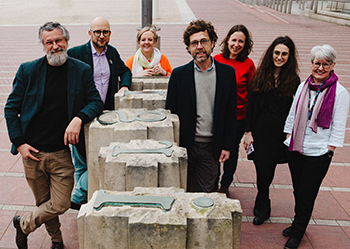University News Last updated 22 March 2024

Demystifying the work of John Baskerville, the Birmingham inventor and entrepreneur who revolutionised the world of printing, is one of the key objectives of a new £1 million research project led by Birmingham City University (BCU) and the University of Cambridge (UoC).
To mark the 250th anniversary of Baskerville’s death, researchers will use a blend of pioneering digital technology and traditional methods to examine the work of the 18th century cultural icon, who created one of the world’s most widely used and enduring typefaces.
“John Baskerville is a figure writ large in typographic history,” said Dr Caroline Archer-Parré, Professor of Typography at BCU.
“A Birmingham genius with a worldwide influence, Baskerville's typeface has both historical significance and contemporary relevance.”
Marcos Martinon-Torres, Professor of Archaeological Science at the UoC, said he was excited to deploy the laboratory facilities and expertise of the Cambridge Heritage Science Hub (CHERISH), to “reveal the trade secrets of 18th century printing”.
He added: “Very much in Baskerville’s footsteps, we are disregarding disciplinary boundaries between art and craft, humanities and sciences.”
At the centre of the project, which is being funded by a £1 million grant from the Arts and Humanities Research Council, are the world-famous Baskerville typographic punches, which were designed, cut and used by Baskerville’s Birmingham workshop in the 1750s.
Numbering more than 2,000, the punches represent a key step in the production of typefaces for the printing press – but one protected by trade secrets and only rarely preserved.
Researchers will look to decode the design and manufacture secrets preserved in the punches and unravel their origin story using microscopy, chemical analysis and advanced imaging.
Jewellers, engravers, blacksmiths and typeface designers will also set about demystifying the craft with their own practical experiments, while learning historical techniques to add to their trade.
“We have a rare opportunity to investigate the tools of John Baskerville’s profession – his typographic punches,” said Dr Anne-Marie Carey, Associate Professor of Jewellery at BCU.
“Baskerville’s master punches are the only evidence we have of his workshop. Yet hidden within those punches are the clues to their manufacture.
“Led by a holistic approach and through a multi-faceted team of expertise, this project is an exceptional opportunity to study and decipher Baskerville’s punches in their fascinating detail.”
Through the power of 3D modelling, the punches will be recreated and used by craftspeople and students during events and exhibitions, to preserve and adapt heritage skills for the future.
A more faithful digital version of Baskerville's original typeface will also be designed and free to use.
Maciej Pawlikowski, Head of Cultural Heritage Imaging Laboratory at Cambridge University Library (CUL), believes the project will deepen understanding of the punches.
“John Baskerville was translating his design ideas between different media and materials during his printmaking practice,” he said. “We will now translate this to a digital object in its own right, bringing those artistic concepts to the public and craftsmanship community as invaluable assets.”
Baskerville, whose masterpiece was a folio Bible published in 1763, was born in the Worcestershire village of Wolverley on 28 January 1706 and died in Birmingham on 8 January 1775.